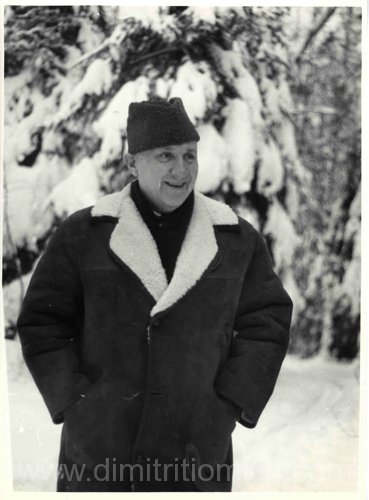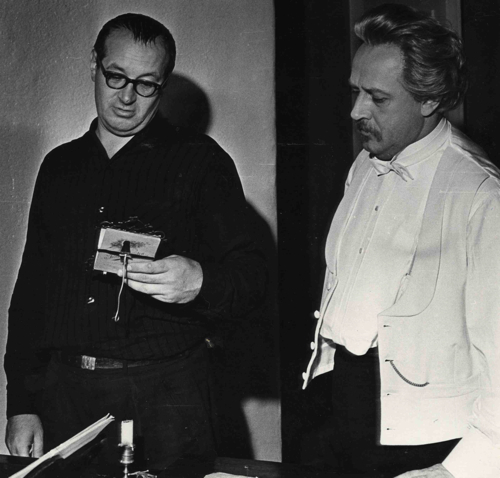
Dimitri Tiomkin in Moscow, Russia, 1965 or 1966
This portrait of Dimitri Tiomkin bundled up and dressed in a fur-lined coat was taken in snowbound Moscow on one of several trips by the composer and producer to the USSR in 1965 and 1966.
What drew Tiomkin to Moscow during the Cold War?
A film co-production between the U.S. and the Soviet Union was announced in February 1966 by Wolfe Cohen, president of Warner Bros. Pictures International. The film would depict the life of Russian composer Peter Ilyich Tchaikovsky and was to be photographed in the Soviet Union by the Soviet Ministry of Cinematography. Dimitri Tiomkin would supervise the entire production, estimated at a cost of $8 million.
Tiomkin was in Russia the previous fall when the Society of Motion Picture and Television Engineers (SMPTE) sent its second delegation to Moscow to gain an impression of the Russian film industry. The delegates toured Mosfilm Studios along with Russian film laboratories and film schools and visited with workers at the USSR Association of Film Workers. Tiomkin hosted a reception for the delegation on October 15, 1965.

Excerpt from “Technical Report of a Visit in 1965 to Motion-Picture Facilities in the USSR,” Journal of the Society of Motion Picture and Television Engineers, Volume 75, June 1966
Fast forward to Spring 1966, Tiomkin, in his role as executive producer of Tchaikovsky, headed to Moscow in April to lay groundwork for the film after meetings with studio head Jack L. Warner in Hollywood; Wolfe Cohen and Warner Bros. executive vice president Ben Kamelson in New York; and with representatives of opera singer Maria Callas in London.
Before leaving for Moscow Tiomkin touted Russian actor Innokenti Smoktunovsky for the title role. By June, Smoktunovsky had been announced, along with screenwriter Yuri Nagibin and director Michael [Mikhail] Romm. [Igor Talankin would direct the film.]
VIEW: Gallery photographs for Tchaikovsky
According to the 2014 book, Cold War Crossings, “In the tense political atmosphere the cultural exchange agreement [between the U.S. and USSR] expired at the end of December 1965 without approval for renewal.” After a planned coproduction of Meeting at a Far Meridian fell apart for political reasons, a coproduction of Tchaikovsky was announced that would use the same Soviet cultural leaders and creative team put in place for Meeting at a Far Meridian.
Tiomkin was a guest at the International Tchaikovsky Competition in Moscow on June 30, 1966. That year marked the first time the competition was held in the summer, an annual tradition ever since.
A U.S. Congressman’s encounter with Tiomkin in Moscow can be found in the Congressional Record, the official record of the proceedings and debates of the United States Congress, dating from October 18, 1966.
“Also from Hollywood we met Dimitri Tiomkin who did the music “The High and the Mighty,” “High Noon,” and many other hits. He’s a formidable name in music…and in conversation. He talked a solid, unbroken line.” “He was in Russia trying to get permission [to film Tchaikovsky].”
Back in Hollywood, Alexis Kapler, secretary of the Soviet Cinematographers Union and president of the USSR Screen Writers Union, talked about the planned film at the opening session of the first world Congress of the International Writers Guild in October 1966. The congress delegates, including Kapler and Tiomkin, discussed challenges to international coproductions, censorship, and copyright laws.

Alexis Kapler and Dimitri Tiomkin, “Warner-Soviet Film Plan Seen as Help in Easing Tensions,” by Harry Bernstein, Los Angeles Times, October 12, 1966
In December Tiomkin was off on his sixth mission to Moscow in a year. The genesis of the project came to light in an article that month. He told Associated Press Movie-Television writer Bob Thomas that he had originally been signed to produce a dramatic-musical subject for National General’s proposed theater-television system [one of three theater television systems in development; perhaps conceptual precursers to Landmarks Live in Concert] on the life of Tchaikovsky. After National General dropped out, and based on the success of the musicals My Fair Lady and The Sound of Music, Tiomkin solicited Warner Bros.
The Russians were to pay the production costs with Warner Bros. guaranteeing certain payments in return for distribution rights throughout the world, except for Communist countries and Finland.
Tiomkin added, “I found the Russians very enthusiastic about this film. They have seen the French and Italians crack the American film market; now they want to do the same.”
Tiomkin said the Russians were familiar with his work through such films as The Great Waltz and The Battle of Russia.

Battle of Russia US one sheet poster
“Even though Warner Brothers pulled out at the last minute, the Russian version of Tchaikovsky appeared in 1969.” (Cold War Crossings, p. 198)
Upon its eventual release in the U.S. in 1971, Tchaikovsky was nominated by the Academy of Motion Picture Arts and Sciences in the categories of best Foreign Language Film and Music (Scoring: Adaptation and Original Song Score).

Igor Talankin, left, with Innokenti Smoktunovsky
Tenth in an occasional series featuring rare or unusual photographs. “Behind the photograph” debuted back in 2011 and coincidentally featured Dimitri Tiomkin at the London premiere of Tchaikovsky.
Sources
“Technical Report of a Visit in 1965 to Motion-Picture Facilities in the USSR,” Journal of the Society of Motion Picture and Television Engineers, Volume 75, June 1966 [on the second SMPTE delegation to the Russian film industry]
Congressional Record, Appendix, Volume 112, Part 30, October 18, 1966, page A5374
“U.S., Russia Cooperating on Film,” Phoenix Arizona Republic, February 22, 1966
“Life of Tschaikovsky Will Be U.S.-Russ Film,” Los Angeles Times, April 4, 1966
“Movie Call Sheet: ‘Tschaikovsky’ Star Named,” Los Angeles Times, June 17, 1966
The Film Daily, volume 128, June 22, 1966
“Warner-Soviet Film Plan Seen as Help in Easing Tensions,” by Harry Bernstein, Los Angeles Times, October 12, 1966
“Dimitri Tiomkin Will Produce Soviet-American Film Venture,” by Bob Thomas, Ogden Standard Examiner, December 13, 1966
Babiracki, Patryk, Kenyon Zimmer, and Michael David-Fox, editors. Cold War Crossings: International Travel and Exchange Across the Soviet Bloc, 1940s-1960s. 2014.
Check out other photographs in this series…
9. Behind the photograph: Dimitri Tiomkin portrait by Gyenes
8. Behind the photograph: Eddie Cantor and the Albertina Rasch girls
7. Behind the photograph: Hollywood portfolio, Dimitri Tiomkin
6. Behind the photograph: The Great Waltz
5. Behind the photograph: Leonard Liebling
4. Behind the photograph: Rhapsody in Blue
3. Behind the photograph: Hairston and Tiomkin
2. Behind the photograph: Tansman and Tiomkin
1. Behind the photograph (Dimitri Tiomkin with His Excellency the High Commissioner for Kenya, Mr. Ng-Ethe Njoroge and Mrs. Njoroge at the London premiere of Tchaikovsky)
